A Private ‘Goose Spectacular’ Tour today, an early start up on the Wash to watch the amazing sight of tens of thousands of Pink-footed Geese leaving their roost and flying inland to feed at dawn. It was a fabulous day too, once the sun came up, with mostly blue sky and sunshine and just a very light easterly breeze.
As we arrived on the seawall, it was still dark but the sky to the east was just beginning to lighten. As we got out of the car and started to don our coats, we could hear thousands of Pink-footed Geese calling out on the Wash. Soon after, the first skeins, the early risers, flew in over us, hard to see in the gloom but we could make out their silhouettes and hear them calling.
As the sun started to come up we were treated to an amazing sunrise. At first the horizon glowed, yellow and orange. There was cloud still out over the Wash which extended slightly inland from us, but to the east the sky was clear. The cloud started off black, contrasting with the dark blue sky, but gradually the light started to catch the edges of the clouds and turned them shades of pink and red, all reflected in the water of the old gravel pit below. Stunning! The sunrise alone was worth getting up early for.

More waves of Pink-footed Geese came in overhead. They were still all but impossible still to see as they took off from the Wash, in the dark to the west of us, and against the dark brown mud, but as they came into the paler sky above the seawall we could make them out more clearly, in a series of ‘v’ formations, hundreds at a time. We could hear their high-pitched yelping calls.
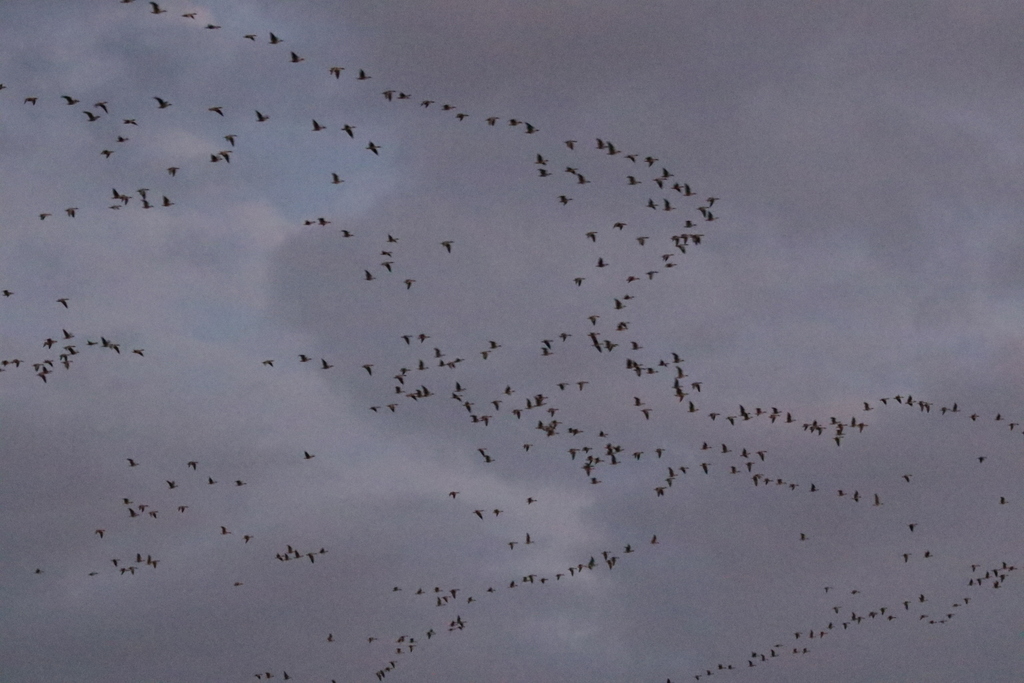
As the skies continued to lighten, we could see the skeins of geese taking off from the mud now. The waves started to get bigger, thousands of birds at a time, taking off in a rising cacophony of noise.
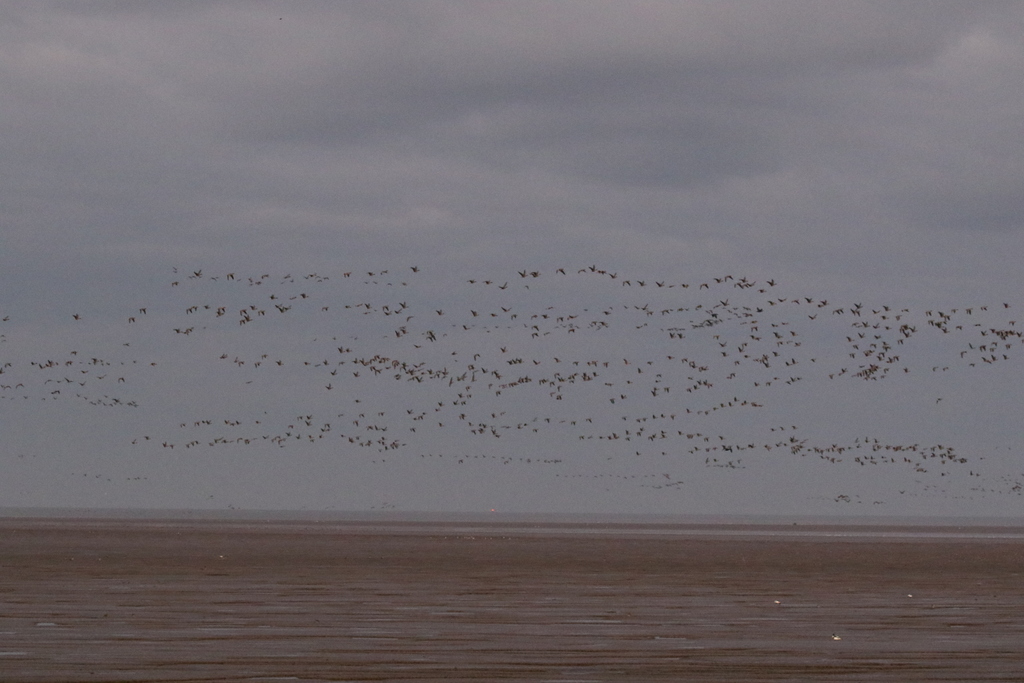


With a bit more light now, we could get some of the Pink-footed Geese in the scope, where they were roosting. Even though quite a few had already left, as we scanned across we could still see thousands upon thousands standing out on the mud, like a vast dark smear.
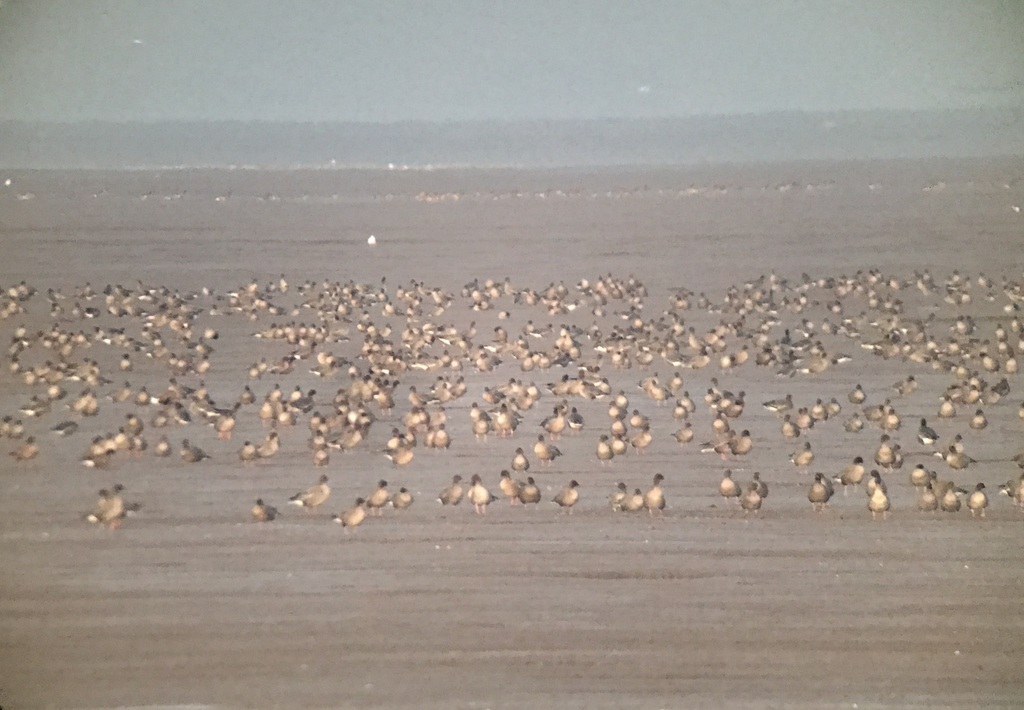
There were several much smaller gaggles of Greylag Geese much closer in, on the near edge of the Wash. They were noticeably paler than the Pink-footed Geese, with large orange carrots for bills. As they took off and flew much lower over the seawall, their calls were much deeper, very different than the Pinkfeet. Coming from much further out, the Pink-footed Geese had more time to gain height out over the Wash before they got to us.
For well over an hour, the Pink-footed Geese kept coming. Each time a huge wave took off and flew in over us, heading off inland, we looked back out to the Wash and could still see thousands and thousands still on the mud. Still they kept coming.


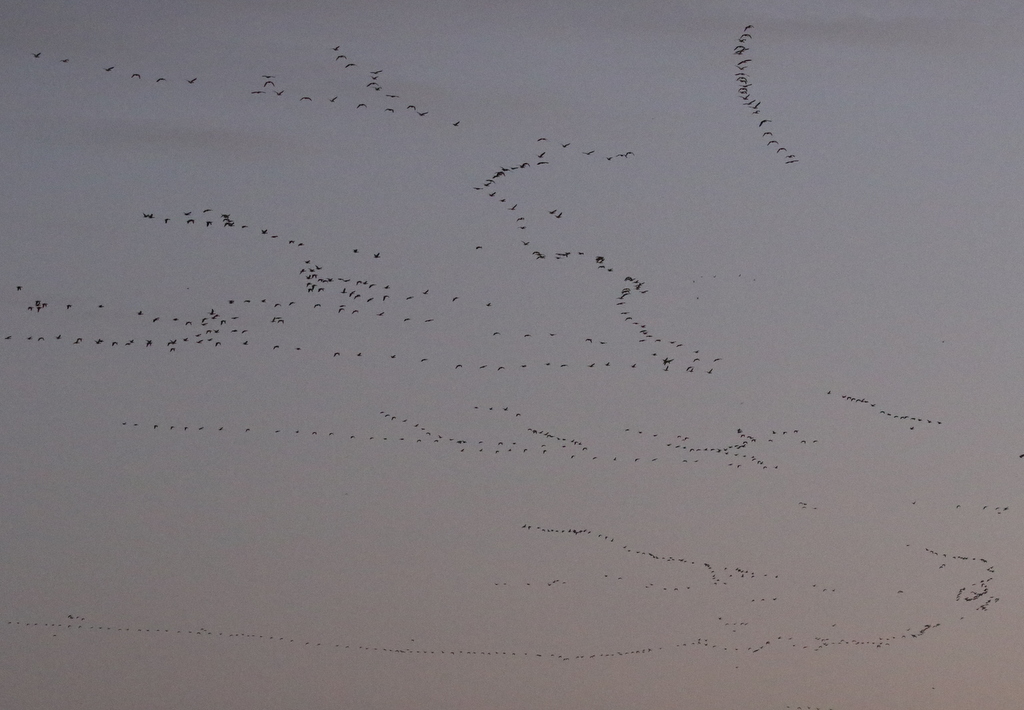
Eventually, gradually, the number of Pink-footed Geese left out on the mud started to dwindle. There are around 30,000 Pink-footed Geese roosting here at the moment, an impressive number and amazing to watch them like this, heading inland to feed. Finally, just a few hundred stragglers were left, so we turned our attention to the other birds.
We could hear Curlews calling while we were watching the geese, and several large flocks flew in from the Wash too, though nothing like on the scale of the Pinkfeet. There were gulls which had roosted out on the safety of the mudflats as well, which flew off inland as the day dawned, in long silvery-white lines catching the early light.
The Wash is also famous for its waders. It was almost high tide now, but not a big enough tide to cover all the mud and push the waders off today. We looked across to the water’s edge and could see some large gatherings of Knot, Bar-tailed Godwits and Oystercatchers. There were ducks too, mainly Shelduck, Mallard and Teal, but with a few Pintail out on the water.
There had been a light frost overnight and there was still a chill in the air, waiting for the sun to rise fully. We decided to go for a walk to warm up, and have a look in the hides overlooking the pit. There were lots of ducks around the islands and margins, mostly Wigeon, but with smaller numbers of Teal, Shoveler and Mallard.
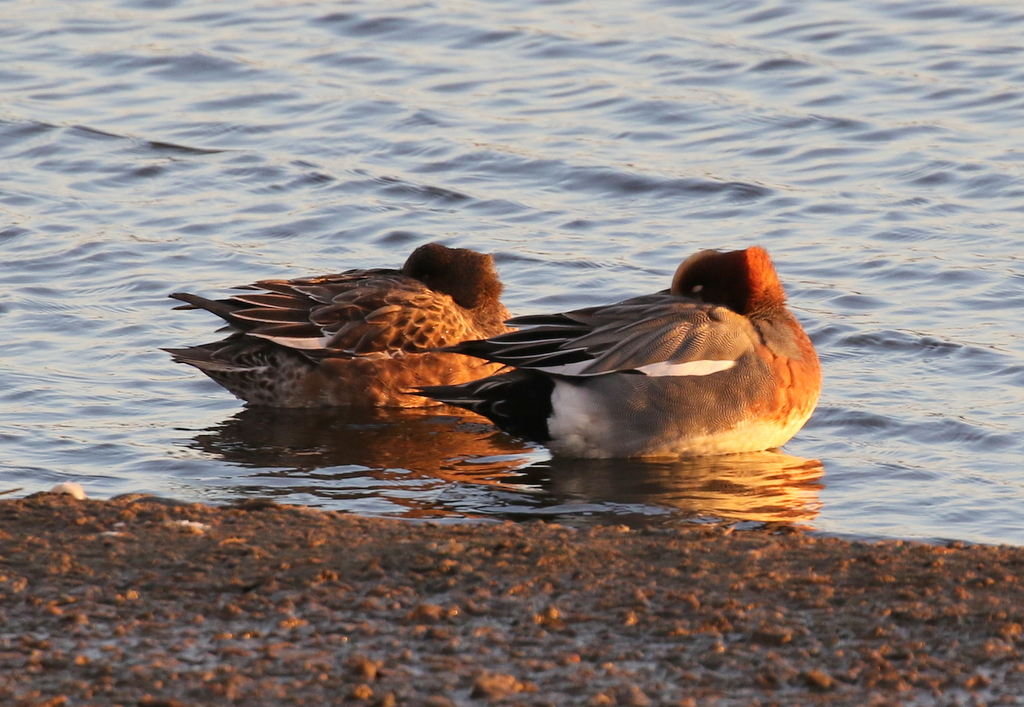
A few Tufted Ducks and Goldeneye were busy diving out in the middle, along with several Little Grebes, one of which helpfully surfaced just below the hide at one point. A large mob of noisy Greylags, birds which had flown in from the mud earlier, were arguing amongst themselves. The waders were mostly out on the Wash today, and there were just a few Lapwing scattered around the islands on the pit.
As we walked round towards South Hide, we stopped at the corner to scan the saltmarsh. A Common Buzzard was perched on a post in the distance and several Marsh Harriers circled up, with four together at one point. Then a smaller harrier appeared, over in the corner, and as it turned we could see it was paler below with a distinctive white square patch at base of tail – a Hen Harrier. We watched it circle for a while before landing down in the vegetation, from where a passing Marsh Harrier stopped to flush it again, the two of them then circling together briefly providing a nice comparison.
It was quiet at the southern end of the pit today. A Little Egret was busy fishing in the pool just below South Hide. We watched as it walked round, stopping regularly and jiggling one foot in the water in front of it to see if it could flush out any prey from the mud.

We walked back on the path around the other side of the pit. It was rather quiet, although a Ruff flying past was a nice bonus for here. We were hoping perhaps to find an owl still out hunting but it looked like they had all gone to roost. However, we did find a Short-eared Owl roosting under bramble bush. It was very well sheltered from disturbance and looking out to the morning sun for a bit of warmth.

Then it was back round to the car for a welcome coffee break. Looking out across the Wash, a huge flock of thousands of Knot had gathered to roost out on the middle of the mud over high tide, and were shining in the morning sun.

After coffee, we made our way round via Hunstanton and up to the north coast, where we popped in to Thornham Harbour to see what we could find. A Black-tailed Godwit and a Curlew were feeding in the channel by the Coal Barn when we arrived, and more waders were in the harbour channel beyond the sluice – several Redshanks, a couple more Curlew, a Bar-tailed Godwit with two Black-tailed Godwits, a Grey Plover and a single Ringed Plover.
Climbing up onto the seawall, a flock of Goldfinches were feeding in the vegetation on the edge of the saltmarsh below the bank. We could see several Linnets with them and then spotted a Twite too. It was colour-ringed – a bird ringed in Derbyshire in May of this year. When something spooked them and all the finches flew up, we realised there were actually five Twite, the others having been hidden from view. They all circled round several times and eventually three of the Twite landed on a wooden post just across the harbour, where we had a lovely view of them through the scope in the sunshine.
Suddenly we heard lots of Pink-footed Geese calling in the distance, and we turned to see a large flock of several thousand come up from the fields inland, beyond the trees. They were presumably birds we had seen flying out from the roost at the Wash earlier. Some circled round and disappeared back down behind the trees, but others flew over towards the grazing marshes at Holme. This is an area they often like to loaf when they are not feeding and we had hoped to find some closer, on the ground today, so we could get a better look at them.
About half of the Pink-footed Geese seemed to drop down in the fields further back, but the rest looked to be landing closer to the bank, so walked along to the next corner of the seawall to see if we could get a look at them. When we got there, we found they were mostly hidden behind a fence, but we could see a few through a gap in the vegetation and got a fairly good look at them in the scope.
There were other birds here to look at too though. Several Skylarks flew up from the grazing meadows and a little group of Meadow Pipits landed in the top of a small bush. A female Stonechat appeared on the edge of the saltmarsh the other side. We could hear Bearded Tits calling from the reeds below the bank. There were lots of Golden Plover and Curlew in the field nearest to us.
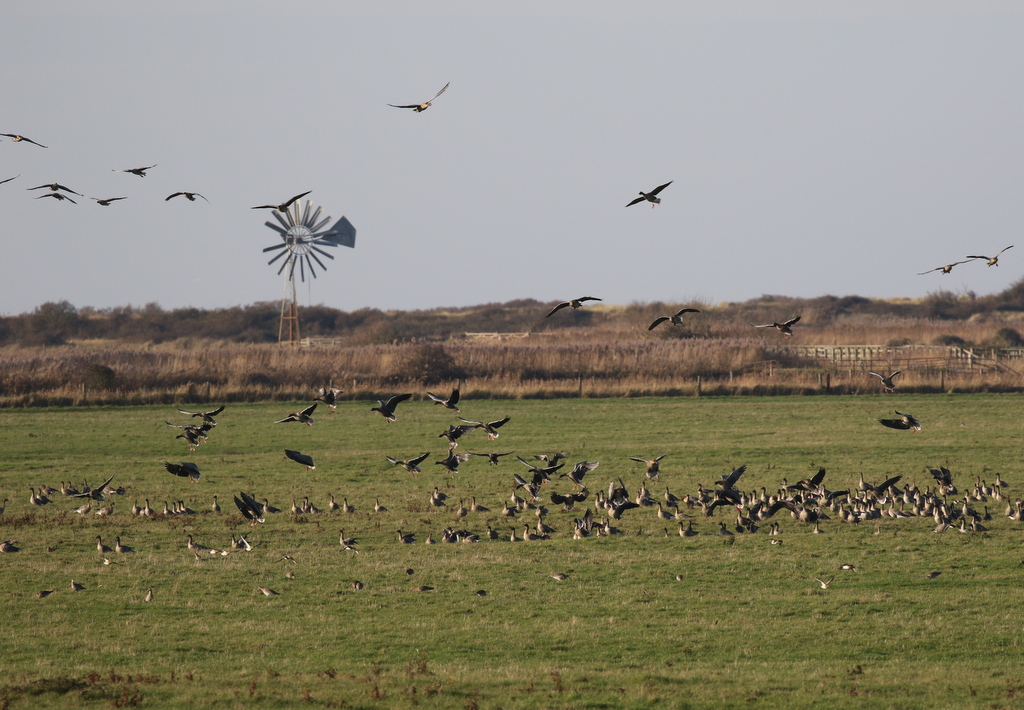
Something flushed the rest of the Pink-footed Geese again from the fields inland, and they flew in to join the rest on the grazing marshes. Most landed out of view again but this time some landed in the field in front of the fence, closer to us. We could see their pink legs and feet catching the light in the sunshine as they came in to land, and we had a better view of them through the scope down in the grass.
As we made our way back to the car, we came across some other birders in the car park. The Twite had come in to bathe in the puddles there. We stopped to watch them too – we could see their yellow bills and orange breasts as they flapped and splashed.

Our next stop was at Titchwell. There were a few finches and tits on the feeders by the visitor centre as we passed. We then stopped to watch a Water Rail which was feeding in the ditch just below the main path. These are normally very secretive birds but there is often one which can be found here in winter, with a bit of searching. We watched as it rooted around in the rotting leaves in the bottom of the ditch. It was very well camouflaged but we could see the leaves flying.

There were three Marsh Harriers circling over the back of the reedbed and a small group of Gadwall at the back of the reedbed pool as we walked out.
The water levels on the Freshmarsh are coming up fast now, as they are raised for the winter. Consequently, there are not so many waders. At least 16 Avocets are still clinging on for the winter and were roosting on one of the few remaining islands. The wildfowl doesn’t mind the increased water though. A gaggle of Brent Geese were swimming on the edge of the reeds, chattering noisily. The ducks like it too – there were plenty of Shelduck, Wigeon and Teal, and a few Shoveler.
We called in briefly at Parrinder Hide. In the middle of the day with the sun shining, we were looking straight into the light from here but we wanted to check quickly whether there was anything else on the islands in front of the hide. Several Dunlin were picking around on the wet mud, but not much else different here today.
The Volunteer Marsh in front of the other half of Parrinder Hide was rather quiet, apart from a few Shelducks and Curlews. Back on the main path, another Curlew and a Redshank were feeding in the channel below the bank.
The non-tidal ‘Tidal Pools’ are very full of water at the moment. The ducks were all tightly packed in on the last bit of remaining island, and a careful scan revealed a drake Pintail asleep among the Wigeon. Otherwise, there were not many waders here, just a few more Black-tailed Godwits and Redshanks.
With the sun at our backs, it was glorious out on the beach. The tide was still just going out, and the mussel beds were still covered. The Oystercatchers were still roosting on the sand and looked great in the light. Several Turnstones and Sanderlings were running in and out between them. Several Bar-tailed Godwits were probing in the sand on the shoreline, with another having a bathe in a pool at the bottom of the beach.
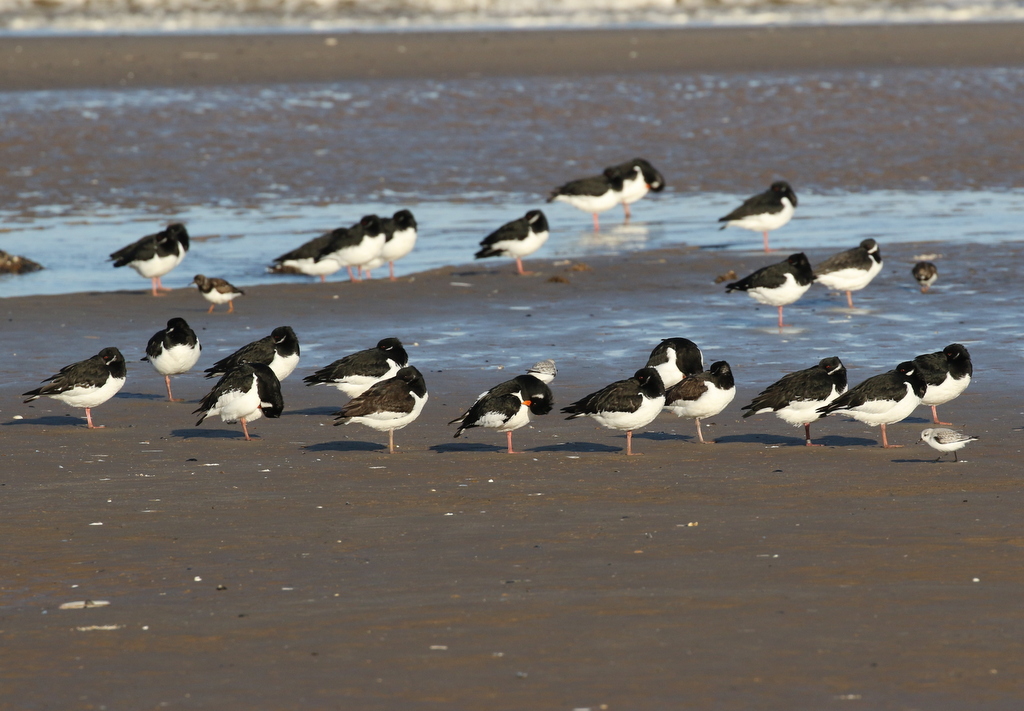
In the light winds the sea was calm. We had a quick scan but the birds were a long way out today. A distant couple of Great Crested Grebes caught the light and a Goldeneye was diving offshore.
After stopping to admire the view from the beach, it was time to head back. It had been an early start this morning. Two Egyptian Geese out on the Thornham grazing meadow rounded out the goose list for the day. Three Wrens chasing around the undergrowth just past the Visitor Centre and a Red Kite over the fields on the way home were the final additions to the overall tally on a very enjoyable day out.
















